MALLRATS (1995)
Both dumped by their girlfriends, two best friends seek refuge in the local mall.
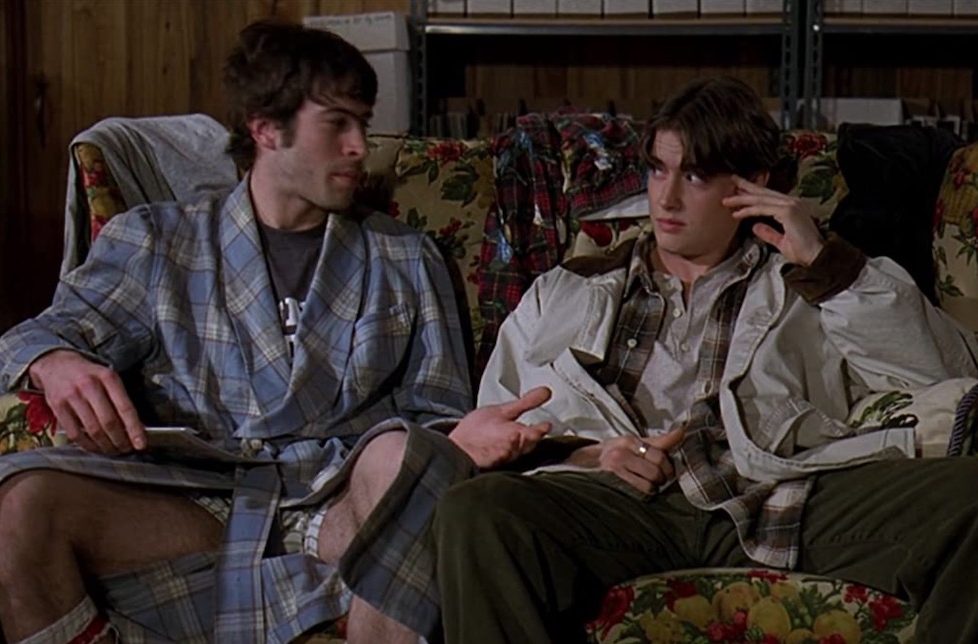
Both dumped by their girlfriends, two best friends seek refuge in the local mall.


Today, Kevin Smith seems content with running his Smodcast empire, directing sequels and spin-offs in ‘View Askewniverse’, and preaching to his congregation of Twitter followers. However, in the 1990s the writer-director was the catalyst for several shifts in US pop-culture: he established a strong online presence with his Silent Bob Speaks blog before social media was propelled into the zeitgeist, he introduced hardcore geek-culture to Hollywood decades before The Big Bang Theory (2005-17), and one could argue he created a ‘cinematic universe’ decades before Marvel Studios. He was a man truly ahead of his time.
Like several other indie filmmakers of the ’90s, Smith was a member of the “video store generation”. For a select age group, video stores were to filmmakers what bookstores were to writers; a cinematic haven where many of today’s best directors—including Quentin Tarantino (Reservoir Dogs), Paul Thomas Anderson (Punch-Drunk Love), and Luc Besson (Leon)–first studied their craft. Like his contemporaries, Smith spent his formative years managing the checkout lines, while watching the likes of Animal House (1978) and The Breakfast Club (1985) on heavy repeat, and helping customers with knowledgeable recommendations.
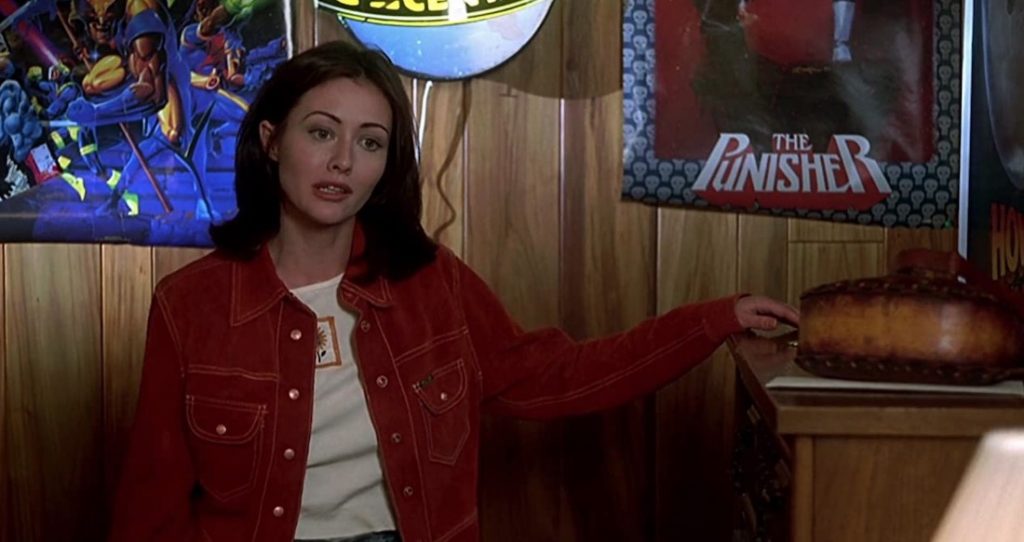
After spending years working in a video store, Smith decided to enrol in film school. It was here he befriended producer and long-time collaborator, Scott Mosier. Four months into his studies, he then made the fateful decision to quit retail, reasoning that making his own film was a better use of his money. In his 2012 book of memoirs, Tough Sh*t, Smith explains “I was 21, I saw Richard Linklater’s film Slackers, and it moved me. I said, If this guy can tell stories about his people in Nowheresville, USA. This is what I want to do”. He also added “I never saw me and my friends totally represented. Our wackiness and adventures weren’t cinematic. We’d sit around and talk about Star Wars for way too many hours.”
Once Smith returned home to New Jersey, he continued writing a screenplay that would eventually become Clerks (1994). Produced with a paltry sum of $27,000 from loans and credit cards, the writer-director created a low-budget picture based on a day in the life of a depressed store clerk. In ’94, his debut sent shockwaves throughout Hollywood and won awards at both Cannes Film Festival and Sundance Film Festival. Smith showcased a sense of originality and raw innovation that seemed to blossom from his shoestring budget. Clerks was a hilarious reflection of the jaded youth and attitude of Generation X. Rebellious, spirited, and snarling, the humour was magnificently crude with a casually subversive tone.
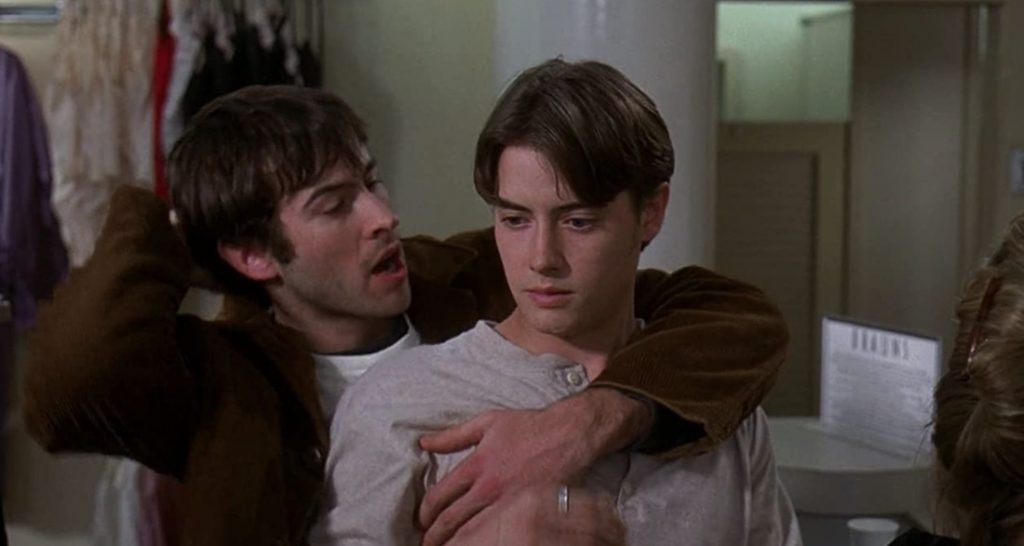
In 1995, mere months after Clerks was released to critical raves and financial success, Smith and his View Askew production team were approached by Universal Studios to repeat their success. Given a budget of $6M, Smith stepped into a studio environment to make Mallrats. Moving from a small-town convenience store to an upscale shopping mall, Mallrats again showcased Smith’s talent for witty dialogue and creating entertaining characters. Although it received a lukewarm reception, Mallrats found success on home video and remains a personal favourite of mine. The filmmaker eventually followed up two years later with the third instalment of his ‘New Jersey Trilogy’, Chasing Amy (1997).
T.S. (Jeremy London) and Brodie (Jason Lee) are two suburban high school friends who’ve both been dumped by their respective girlfriends the same day. They both decide to go to the local mall to commiserate and spend the time talking about comic-books. Along the way, they meet up with their two troublemaking friends called Jay (Jason Mewes) and Silent Bob (Kevin Smith), and upon hearing about a teenage dating game show taking place inside the mall, T.S. realises his ex-girlfriend, Brandi (Claire Forlani) will be participating. Meanwhile, Brodie’s ex-girlfriend, Rene (Shannen Doherty), has begun dating a sleazy store manager Shanon (Ben Affleck). So it’s up to both T.S. and Brodie to disrupt the game show in an attempt to win back their lover’s hearts.
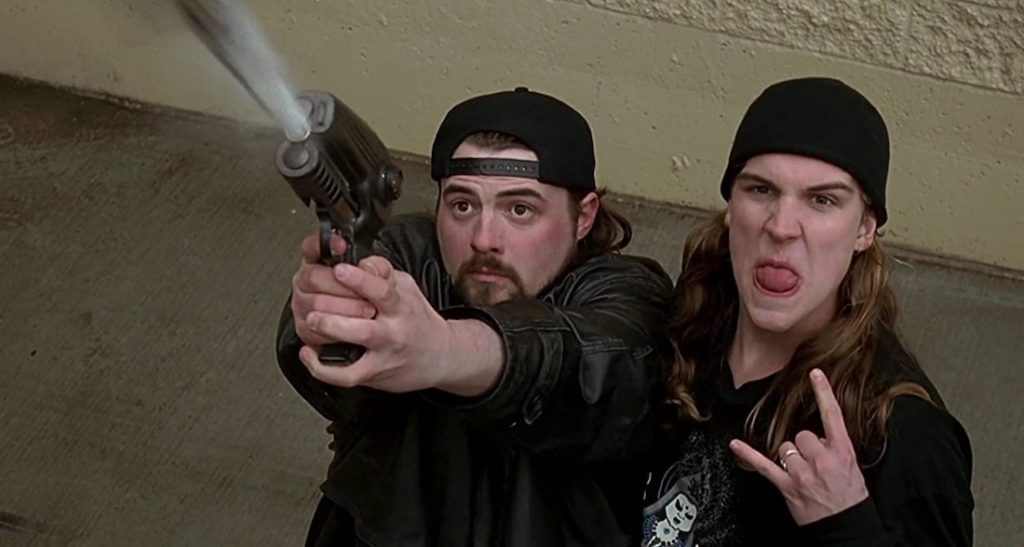
With the help of casting director Don Phillips, Mallrats features an incredible array of young talent. Phillips first made a name for himself after discovering Sean Penn for Fast Times at Ridgemont High (1982), and Mathew McConaughey for Dazed and Confused (1993). Nevertheless, during the time of production, Shannon Doherty had only a handful of feature credits. Although she appeared in Heathers (1989), the actress was mostly recognised for her role in the TV series Beverly Hills 90210. Similarly, Jeremy London was mainly known for playing Griffin Holbrook in the TV series Party of Five (1994-2000). Additionally, Ben Affleck had only just begun to make a name for himself as an actor, starring in Dazed and Confused and Glory Daze (1995). However, what many people don’t know is that on the day of his audition, Affleck had put a price tag on a script he co-wrote with Matt Damon. Several years later Good Will Hunting (1997) came into being, earning them both an Academy Award! Phillips struck gold with the casting of Mallrats, but the notable standout is Jason Lee.
Transitioning from his career as a professional skateboarder to acting, Lee steals the show as Brodie Bruce. Although Smith would cast him in numerous subsequent films, no role was as big for Lee as his character in Mallrats. As the comic-book-loving philosophical slacker that fires off tense debates as much as he does vulgar comments, he’s the ultimate Kevin Smith protagonist. One would never guess he’d never acted before Mallrats. His charisma is off the charts and his likability factor is higher than Smith smoking weed. Lee has such a natural, innate talent for delivering the director’s dense dialogue. Unsurprisingly, it wasn’t long before he became a more mainstream star, headlining Mumford (1999) and Almost Famous (2000), in addition to working alongside greats such as Tony Scott and Gene Hackman in Enemy of the State (1999).
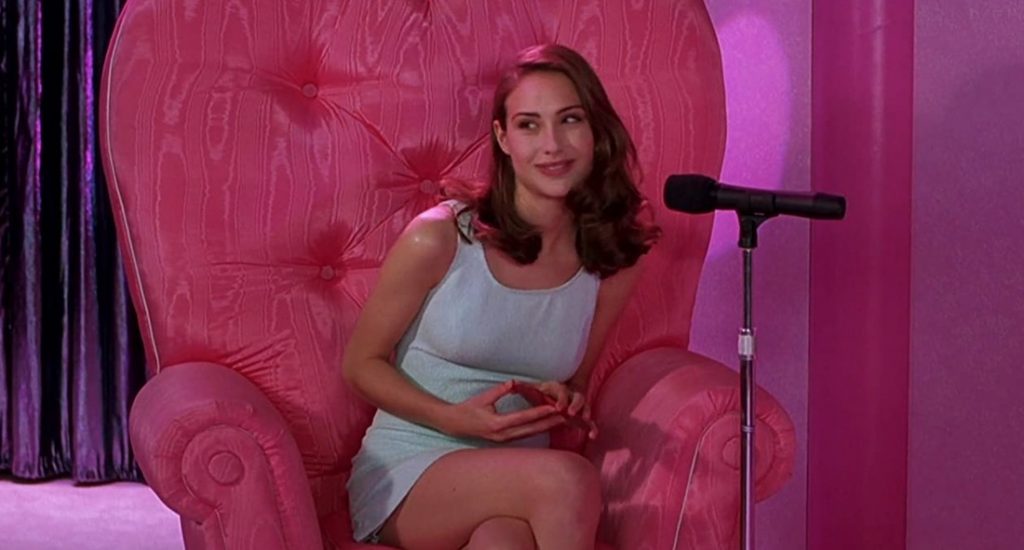
Universal insisted on casting a somewhat recognisable actor with a handsome face in the lead role of T.S Quint, but unfortunately, London seems out of place here. Looking like a young Brendan Fraser, he’s obviously the straight man to the outlandish Brodie. However, his character isn’t compelling enough to make audiences truly root for him. Perhaps it’s due to being overshadowed by Lee’s performance, but T.S is devoid of any tangible charisma. In the DVD commentary, London admits he was stoned during most of the shoot, so this may be the reason for his questionable performance! Alongside London is his romantic co-star Claire Forlani (Meet Joe Black) as Brandi, who ended their relationship to appear on her father’s game show Truth or Date. When compared to Brodie and Rene’s undeniable amorous tension, there’s a lack of chemistry between the lead couple. Thankfully their uninspired performance can be easily ignored due to the rest of the supporting cast.
However small their roles may be, the rest of the ensemble gives fantastic performances. Affleck’s an actor able to portray likeable characters such as A.J. Frost in Armageddon (1998), but also loathsome ones like Fred O’ Bannion in Dazed and Confused. In Mallrats, he gives the latter a try, as his Shannon Hamilton is a nasty scumbag and makes for a great villain. Additionally, Doherty gives a harsh but oddly likeable performance as the strong-willed Rene, who’s reached the end of her tether with her lazy and inattentive boyfriend Brodie. Joey Lauren Adams also adds a pleasant, bubbly sexiness to her character Gwen, returning as the lead in Smith’s next next film Chasing Amy.
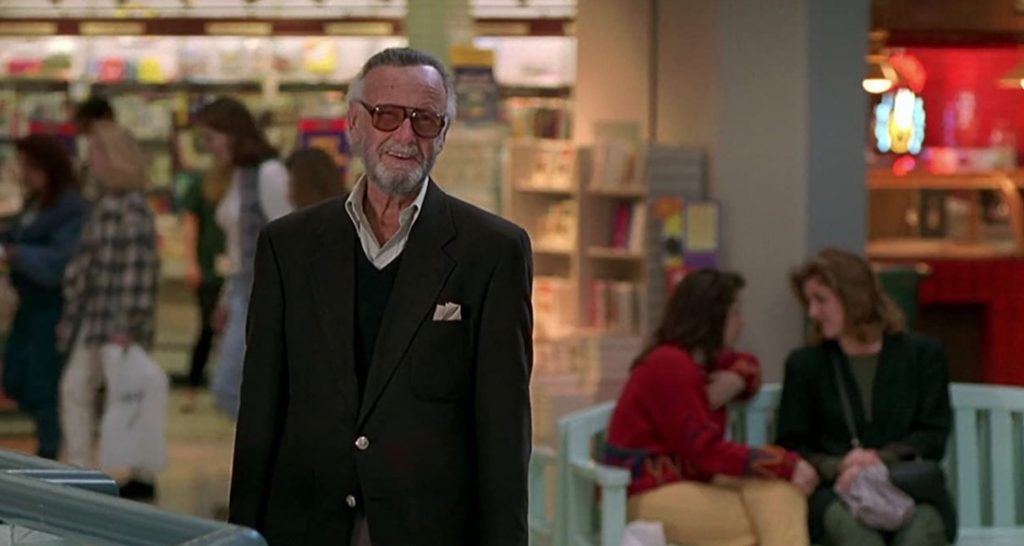
The only returning characters from Clerks are Jay (Jason Mewes) and Silent Bob (Kevin Smith), the quirky duo who hung around in the background of Smith’s breakthrough film. Their role is more prominent than their previous outing and a lot of the humour is centered around them. Mewes delivers some great one-liners and it’s in Mallrats where he coined the catchphrase “snootchie-bootchies”. Whereas Smith uses facial expressions and physical humour to bring Silent Bob to life as an unwitting action hero. Watching him attempt to use The Force to move objects is something most young Star Wars fans can awkwardly relate to. His mishaps as “The Dork Knight” are equally hilarious, as he accidentally crashes into women’s changing rooms, becoming an innocent peeping Tom. Admittedly, their Road Runner and Wylie Coyote subplot involving La Fours (Sven-Ole Thorsen) is juvenile stuff, but not without its charm.
Surprisingly, recasting Mewes as Jay served to be a bigger problem than expected. The character delivered a high number of authentic laughs in Clerks, and this scared the studio executives. Despite Universal’s apprehension, Smith stood behind his decision to keep the actor in the role, but the studio imposed a plethora of conditions and restraints. Initially, they refused to pay for any of his travel expenses, then they demanded that the director should audition Seth Green (Austin Powers: International Man of Mystery). The future looked bleak on the first day of shooting, as several studio suits were on set ready to fire Mewes. Then their attitude changed; they didn’t just like Mewes, they loved him. As a result, Mallrats’ advertising campaign was built around the character Jay and his catchphrase “snootchie-bootchies”.
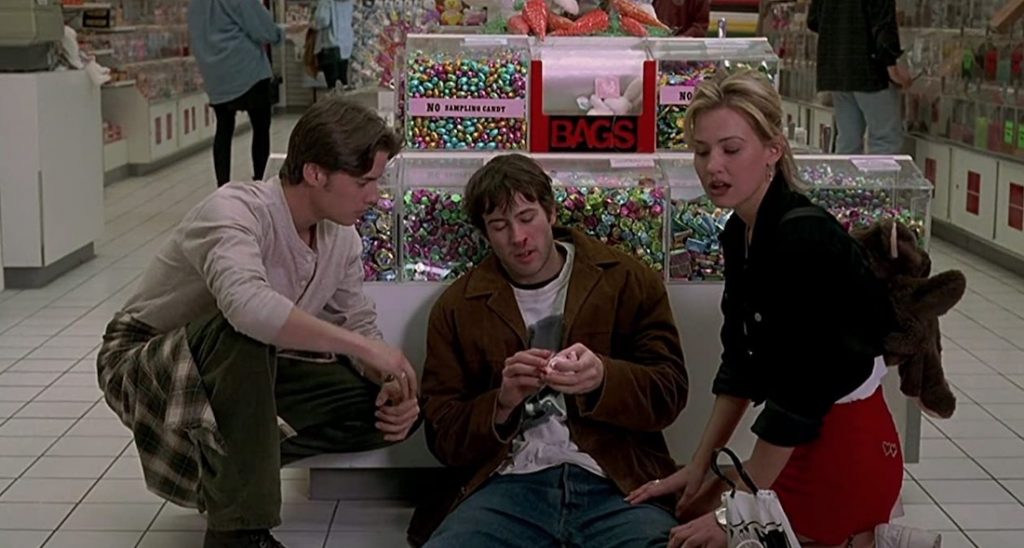
Unfortunately, after a sizeable marketing campaign and backing from Universal, Mallrats was far from a success in 1995. During the opening weekend, it grossed approximately $1M and slowly decreased each week. Overall, making a modest $2.1M from its $6.1M budget. Adding insult to injury, Smith’s sophomore effort was lampooned by critics that had championed his debut so valiantly. Roger Ebert and Entertainment Weekly lambasted it. Thankfully, due to the home video market, Mallrats found a second lease of life. Smith’s second feature quickly became a popular cult hit and is now acknowledged as a classic of the teen comedy genre. However, for the filmmaker, Mallrats was a learning process. Smith would use the experience of the studio environment when he released Dogma (1999) later in his career.
The director imbues Mallrats with his love for comic-books from the opening scene. When the cast is introduced, comic-book artwork depicts them as parodies of famous superheroes. Brodie is seen as ‘Brodieman’ (Superman), T.S. is a character in ‘Defective Comics’ (Detective Comics) and Shannon is ‘Buttman’ (Batman). This underpinning theme is continued throughout with Brodie’s love of comics and Jay and Silent Bob’s antics. However, the piece de resistance is the incredible cameo from Stan Lee. Acting as a guardian angel for Brodie, he puts him on the correct path to rekindle his relationship with Rene. Along with answering Brodie’s relentless questions about superheroes genitalia. Years later, “The Man” would pay homage to Mallrats with his cameo in Captain Marvel (2019) as a subway passenger reading Smith’s original script.

Admittedly, Smith’s pictures aren’t the most visually appealing, as he’s no Martin Scorsese (The Irishman). However, he’s easily one of the best scriptwriters in the industry. Similar to Tarantino, he writes scripts with a unique flair. His juvenile humour and cunningly wrought monologues read as crude, but contain a great deal more wisdom and insight than most people give them credit for. A particular scene where Rene breaks up with Brodie is incredibly poignant. As she’s getting ready to sneak out of his house, while Brodie is sat playing his Sega Genesis, she explains why she sits in the bathroom each morning crying for 30-minutes because she’s in love with someone who has no ambitions. Of course, the way he writes his script is wordy, but his characters feel like real people. He never panders to his audience because he understands them. It takes a good writer to turn a day out to the mall with a group of slackers into something with substance, and Smith pulls it off.
Though many will disagree, one could argue Mallrats was ahead of its time. The gross-out comedy sub-genre wasn’t mainstream popular until the Farrelly brothers released There’s Something About Mary (1998), then the floodgates opened with American Pie (1999), Scary Movie (2000), and Road Trip (2000), etc. All those championed lowbrow, gross-out humour, often to positive notices and box office glory. However, personally speaking, Brodie’s “stink-palm” gag is simultaneously still one of the funniest and most disgusting sequences in any teen comedy of the ’90s. Watching Michael Rooker (Guardians of the Galaxy Vol. 2), as the pompous Mr Svenning, lick the melted chocolate pretzel off his hand, is a stomach-churning riot.
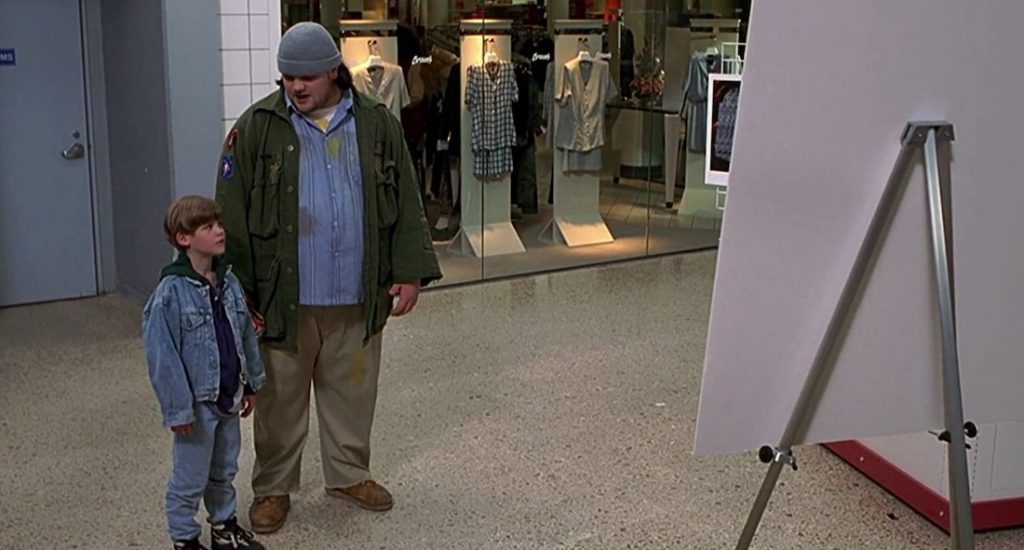
As someone who can remember the ’90s fondly, Mallrats serves as a perfect time capsule to that era. Obviously, the aesthetic is there, but scattered around the background are nuggets of ’90s culture and style. Smith stretches out his $6M budget creating fictional shops such as “Popular Girl”, “Fashionable Male” and “Burning Flesh Tanning Salon”. There’s even a food court ideal for “mid-mall snacking”. Characters wrap their plaid shirts around their waists like they’re in a rock band such as Sonic Youth or Nirvana. Then there’s a repeatedly hilarious scene of William (Ethan Suplee) struggling to see the hidden image in a Magic Eye stereographic 3D poster, which were insanely popular at the time. Perhaps I’m biased because I grew up in this era, but it evokes a sense of comforting nostalgia in me decades later. Similarly to Clueless (1995) and 10 Things I Hate About You (1999), it’s set in a simpler period where smartphones and social media weren’t running rampant because the internet wasn’t at everyone’s fingertips.
Mallrats has a reputation for being a disappointment after the blistering debut of Clerks, but I disagree. Personally, it’s my favourite View Askew offering and holds a special place in my heart. It was through Mallrats where I was first introduced to Kevin Smith and his trademark witty dialogue. 25-years later it remains a well-written sophomore feature. Although many believe it’s not as sharp-witted as Clerks and lacks the provocative themes of Dogma, Mallrats remains relentlessly funny, filled with timeless pop-culture references, and exudes a warm heart.
USA | 1995 | 94 MINUTES | 1.85:1 | COLOUR | ENGLISH

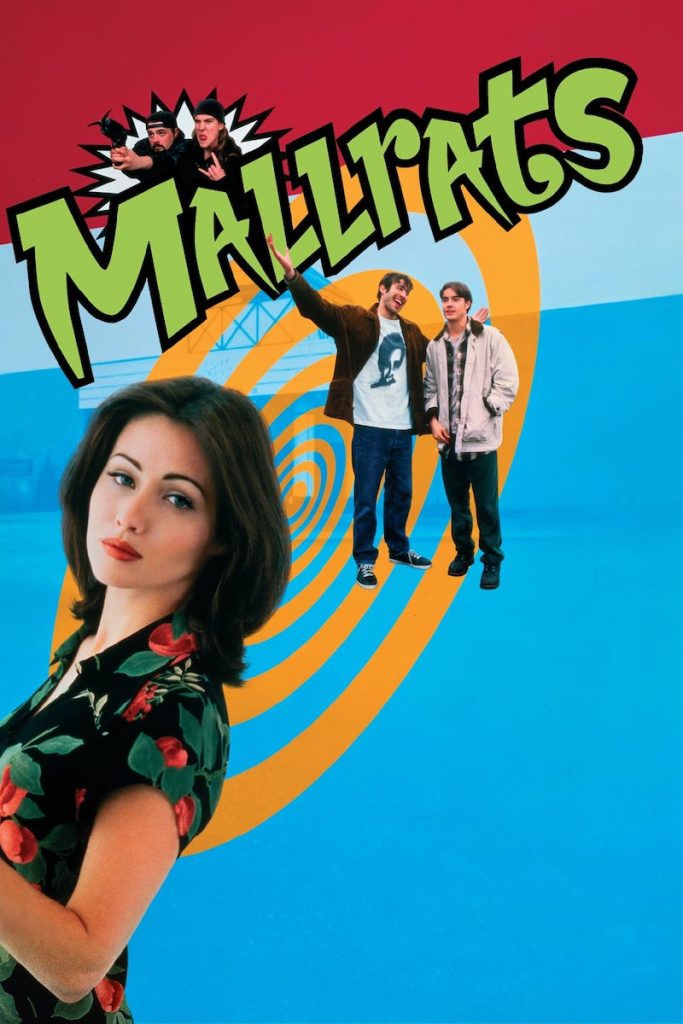
writer & director: Kevin Smith.
starring: Shannen Doherty, Jeremy London, Jason Lee, Claire Forlani, Priscilla Barnes, Michael Rooker, Jason Mewes & Kevin Smith.
